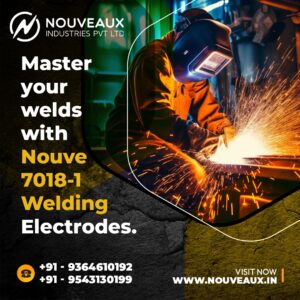
When it comes to achieving high-quality structural welds, the E7018 welding electrode is a popular choice for many professionals. Its unique characteristics, such as excellent mechanical properties, ease of use, and versatility, make it an ideal solution for structural applications. Whether you’re working on buildings, bridges, or heavy machinery, mastering the E7018 electrode can significantly improve your welding results.
In this guide, we’ll explore the proper techniques for using E7018 electrodes, the benefits of using them for structural welds, and common mistakes to avoid. Let’s dive in!
Welding Consumable Manufacturer
What is the E7018 Electrode?
The E7018 is a low-hydrogen, iron powder-coated electrode commonly used for welding mild and medium carbon steels. The “70” in its name refers to the electrode’s tensile strength (70,000 psi), while the “18” denotes its ability to weld in all positions with a low-hydrogen coating that minimizes the risk of cracking.
Why Choose E7018 for Structural Welds?
- High tensile strength: E7018 electrodes produce welds with excellent strength, making them suitable for load-bearing structures.
- Low hydrogen content: This reduces the risk of hydrogen-induced cracking, which is especially important in thick and high-stress weldments.
- Versatility: The E7018 electrode can be used in all positions—flat, vertical, overhead, and horizontal—making it a versatile option for structural work.
- Smooth arc and minimal spatter: The arc is easy to control, leading to clean welds with minimal post-weld cleanup required.
Welding Electrode Manufacturer
Preparing for Welding with E7018
- Dry Storage: E7018 electrodes are sensitive to moisture and should be stored in a rod oven at the manufacturer’s recommended temperature (typically 250°F to 300°F) to prevent moisture absorption. Wet electrodes can lead to porosity and cracking in the weld.
- Workpiece Preparation: Clean the metal surfaces to remove dirt, oil, rust, and paint before welding. This helps prevent contamination of the weld.
- Correct Electrode Size: Choose the right electrode diameter based on the thickness of the metal and the current range recommended by the manufacturer.
Step-by-Step Guide to Using E7018 Electrodes
- Set the Right Parameters
- Amperage: E7018 electrodes typically run best with a DC power source set to the proper amperage range (80-150 amps for a 3/32” rod, 120-225 amps for a 1/8” rod). Check the electrode packaging for specific recommendations.
- Polarity: Use DC+ (Direct Current Electrode Positive) for optimal penetration and bead appearance.
- Voltage: Adjust your voltage setting depending on the position of your weld. Higher voltage is needed for overhead or vertical welds to maintain control.
E7018 Welding Electrode Manufacturer
- Striking the Arc
Begin by striking the arc using a “scratch” or “tap” method to initiate the weld. Keep the arc length short—around 1/8 inch—for a stable and consistent arc. A shorter arc will produce a smoother bead with better fusion.
- Travel Speed and Angle
- Travel Speed: Maintain a consistent travel speed to ensure the weld bead is neither too thick nor too thin. Too fast of a speed can cause insufficient penetration, while too slow can lead to excessive heat input and potential burn-through.
- Angle: Position the electrode at a 10-15 degree angle for flat and horizontal welding. For vertical welds, use a slight upward angle to control the molten pool.
- Maintain Proper Welding Technique
For a flat or horizontal weld, use a slight weaving motion to create uniform weld beads. In vertical or overhead positions, a stringer bead (straight movement) may be more effective for controlling the weld pool.
- Peening and Slag Removal
After completing a weld, allow it to cool slightly before peening (lightly hammering the surface) to relieve stress in the weld. Remove slag between passes to prevent contamination of subsequent layers. Proper slag removal ensures better fusion and a cleaner final weld.
Common Mistakes to Avoid
- Overheating the Electrode: E7018 electrodes can easily overheat if run at too high of an amperage, which can lead to spatter, slag inclusion, and excessive weld pool fluidity.
- Improper Arc Length: A long arc length can cause instability in the arc, leading to defects in the weld, such as porosity or lack of fusion.
- Neglecting to Preheat: For thicker or highly stressed materials, preheating the base metal may be necessary to prevent cracking during cooling.
Final Thoughts
Mastering the E7018 welding electrode is essential for producing high-quality structural welds that meet industry standards. By following the proper preparation, technique, and post-weld care, you can achieve strong, reliable welds suitable for even the most demanding projects.
Whether you’re a seasoned welder or just getting started, the E7018 electrode offers flexibility and reliability, making it a go-to tool for structural welding jobs.
With the right knowledge and practice, you can confidently use this electrode to produce durable, professional-grade welds every time.
